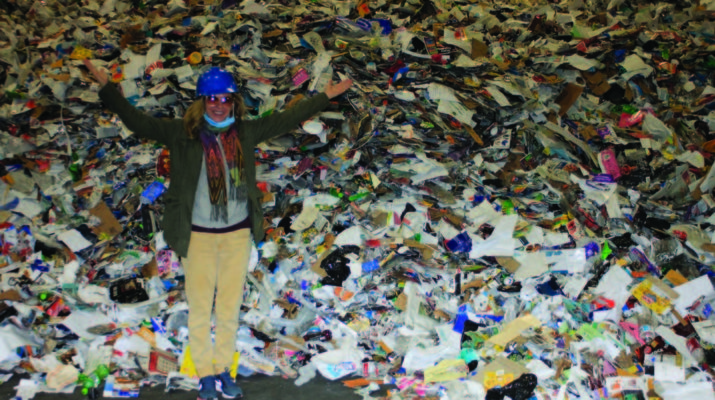Second floor, urban view, mirror mirror on the wall with speakers and — yes — my own one-cup-at-a-time coffee maker! Why the excitement? Well, I wanted caffeine in my favorite form before leaving the hotel room on our recent Keep Alliance Beautiful trip. Also, that cardboard cup, lid and coffee pod would all end up in the same plant where we were heading for a tour thanks to a mini recycling bin behind the bed.
We arrived at Firststar Recycling’s Omaha facility on a Monday morning when I would otherwise have been preparing to ride my bike to work at the KAB recycling center. The Firststar employees we saw performed some of the same duties as our crew in Alliance, albeit on a much larger scale. KAB has yet to reach the one million-pound threshold for material recycled in a year compared to Firststar, which at their Omaha location alone, markets 100,000 tons of materials annually. Another key difference is the nature of the entities located at opposite ends of the state. KAB is not for profit. Firststar makes money through its place in the recycling market place. For those of us on the tour, the use of mechanization and technology caused a little good-natured envy.
Though KAB is not in the business of turning a profit, some of the material we recycle does make money — just not enough to fund the recycling center or the other areas we emphasize, such as education. It was satisfying to see there are large Nebraska companies plugged into the international recycling industry. Firststar’s volume and high tech sorting allow the plant to separate material into individual bales based on customers’ demand. I was impressed with the grades of paper stacked on the concrete floor. Four letter combinations, in all caps, designated each. BSWL, bales sorted white ledger, for example, can go into making more paper at mills our co-tour guide Jeff Heck explained. He added that they handle both pre- and post-consumer paper.
At Alliance, all our sorting is done by hand with assistance from a forklift when feasible. Materials not shipped out in former fertilizer/farm chemical totes goes into two balers. Our bales top out at a little over 1,000 pounds. At Omaha we saw several forklifts/skid steers wherever we went either shunting bales or feeding the massive sorting machines. Their balers are automatic as well with another 1,500- to 2,000-pound rectangular cube always coming out.
Piles of paper (and other things) and stacks of bales that would have made the “Princess and the Pea” at home if she took a nap on one were neat to see. For me, however, the stars of our walkthrough were the green giant mechanical sorters. People stood like birds on the back of a rhinoceros as conveyors hummed, electric eyes scrutinized and giant hoppers ate their fill.
Our other tour guide, Danielle Easdale, filled our contingent in before we climbed the flight of stairs to see how certain materials are separated from others. One machine divided dimensions with a ballistics screen dividing 2D from 3D items. At another place, an optical sorter used a camera to see down to the molecular level to tell the difference between types of plastics. No squinting at those triangles for them. Another optical scanner picks out milk jugs. An overhead magnet pulls out tin/steel cans. Rotating magnets, spinning at different speeds, pull out aluminum cans. Each material goes to its respective bins which the baler can access depending on what type of bales are currently in demand.
We saw bales of items we may have people ask about here but do not have the volume to take. Vinyl siding was one example. KAB has mixed car bumpers in with our No. 1-7 bales though we do not have enough to market on their own. Heck explained this is a separate grade of plastic — TPO.
The tour expanded my appreciation for just how much of what we use can be recycled. That bottle you toss in the KAB trailer today will ultimately take a longer trip than just across the Cornhusker state. Too bad they never learn to send a postcard.

